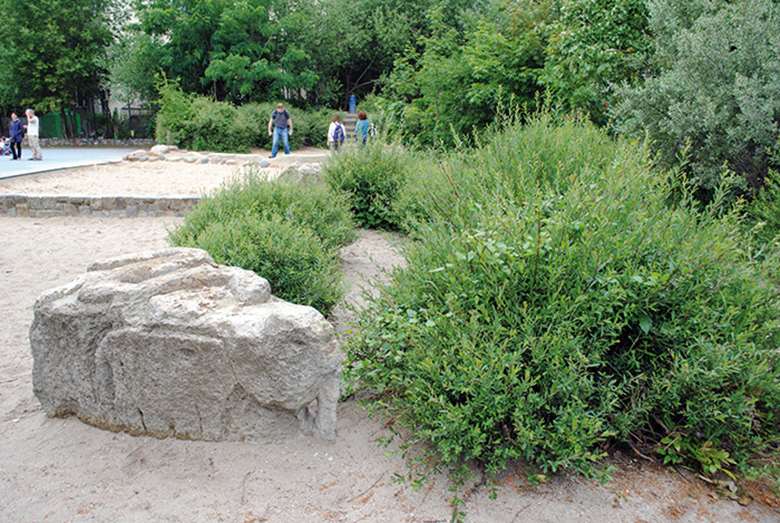International Focus: Redesigned natural playgrounds in Berlin
Derren Hayes
Thursday, May 4, 2017
There are nearly 2,000 public playgrounds in Berlin, a city of four million inhabitants, of which about 500,000 are aged under 18. Statistically, this is a high ratio, but sheer quantity is not what sets Berlin apart.

Guided by what most German parents consider a healthy chance for children to get outdoors and develop self-sufficiency through learning a sense of risk, Berlin playgrounds are physically challenging and ambitious in design. This principle also applies to dozens of the city's school playgrounds.
POLICY AND REGULATION
Over the past two decades, school playgrounds in Berlin have been redesigned. The tarmac courts have been replaced by purposely designed creative multi-functional spaces that combine utilising the natural environment with stimulating play equipment. Using sand, water and bordered areas has ensured play becomes integral to learning and relaxation.
One school collects rainwater from the roof, stores it in underground tanks and pumps it to the surface using solar power. Rain adds an extra dimension to play rather than restricting it.
There are comprehensive planning and design processes that playgrounds in Berlin undergo. Part of the process involves consultation by landscape gardeners with pupils and staff.
Once the city council has granted planning approval, new equipment is installed and trialled for a set period of time. If no accidents are recorded, approval is given by insurers to keep the new feature.
Most of the playground developments have been funded through the European Union. In most cases, pupils and parents were involved in some aspects of the work - as well as ongoing smaller projects such as planting, wall building and sculptures.
The challenging nature of the play equipment is based on the principle that children must be given the opportunity to take risks.
This is in line with the latest version of the European Standard for fixed play equipment, which states explicitly that it is concerned with balancing risks and benefits.
CULTURE AND SOCIETY
Some schools give access to the grounds for play out of school time. For example, one has a sheltered area where parents can sit and talk after school while their children play. It also has two old trams converted into a café to encourage parents to socialise after dropping off or collecting their children.
Most schools have arrangements where parents are involved in maintaining the sites, and a number organise community work days at the weekends when parents and children gather to do maintenance work and enjoy a barbecue or picnic together.
A very different attitude to risk is evident. Playgrounds are designed to create multiple opportunities for "good risk" that can be clearly recognised and assessed. Children jump off rocks into sand with no adult supervision. Play equipment fall heights are up to six feet high. Surfaces are sometimes designed to be uneven and there is a general assumption in favour of risk.
A school that had some children in wheelchairs had constructed gentle slopes for climbing and rolling down - as well as some wheelchair bumps on the paths.
Teachers report that the natural playgrounds create a greater number of minor accidents than the old tarmac spaces - but that there are fewer serious accidents.
PRACTICE
A key theme of playgrounds in Berlin is space to hide and a philosophy that children need to be away from the active supervision of teachers for part of the day.
Planting has been designed to create lots of hidden paths, dens and cover. In some of the grounds, up to 70 per cent of the children are out of view of a supervisor during break time. Instead of circulating, supervisors locate themselves at fixed points so that any vulnerable children can stay close and, if there is any trouble, children know where to find an adult.
At the Abenteuerlicher Bauspielplatz Kolle 37 playground in former East Berlin, children make mud bricks, construct timber windmills and bake bread over an open fire.
Teachers claim that break-time behaviour is better than it was in the old tarmac playgrounds where playground violence was a problem.
IMPLICATIONS FOR THE UK
By Juno Hollyhock, executive director, Learning Through Landscapes
Playgrounds in Berlin allow children to hide, following a philosophy that children need to be away from the active supervision of their teachers for some of the day. In the UK, if we cannot see the children at all times, we worry that they are vulnerable to behaviour problems escalating.
Increasingly, UK schools are embracing the teaching and learning resource available to them in nature and we see more examples such as natural landscapes, fewer fixed prescriptive structures and more use of loose natural materials. Some schools use elements such as sand and water much more in line with Berlin principles. We are seeing an emerging focus on natural play in the early and primary years with mud kitchens and forest schools, and there is more interest in landscape features such as tunnels, mounds and woodland.
However, the spectre of "risk" is always there and until we recognise that we do our children no service by providing a cotton-wool environment at school, this will not change. Children must learn to exist in the natural environment as well as to appreciate it. They must be exposed to its risks as well as its pleasures and must learn how to assess and manage those risks for themselves.




